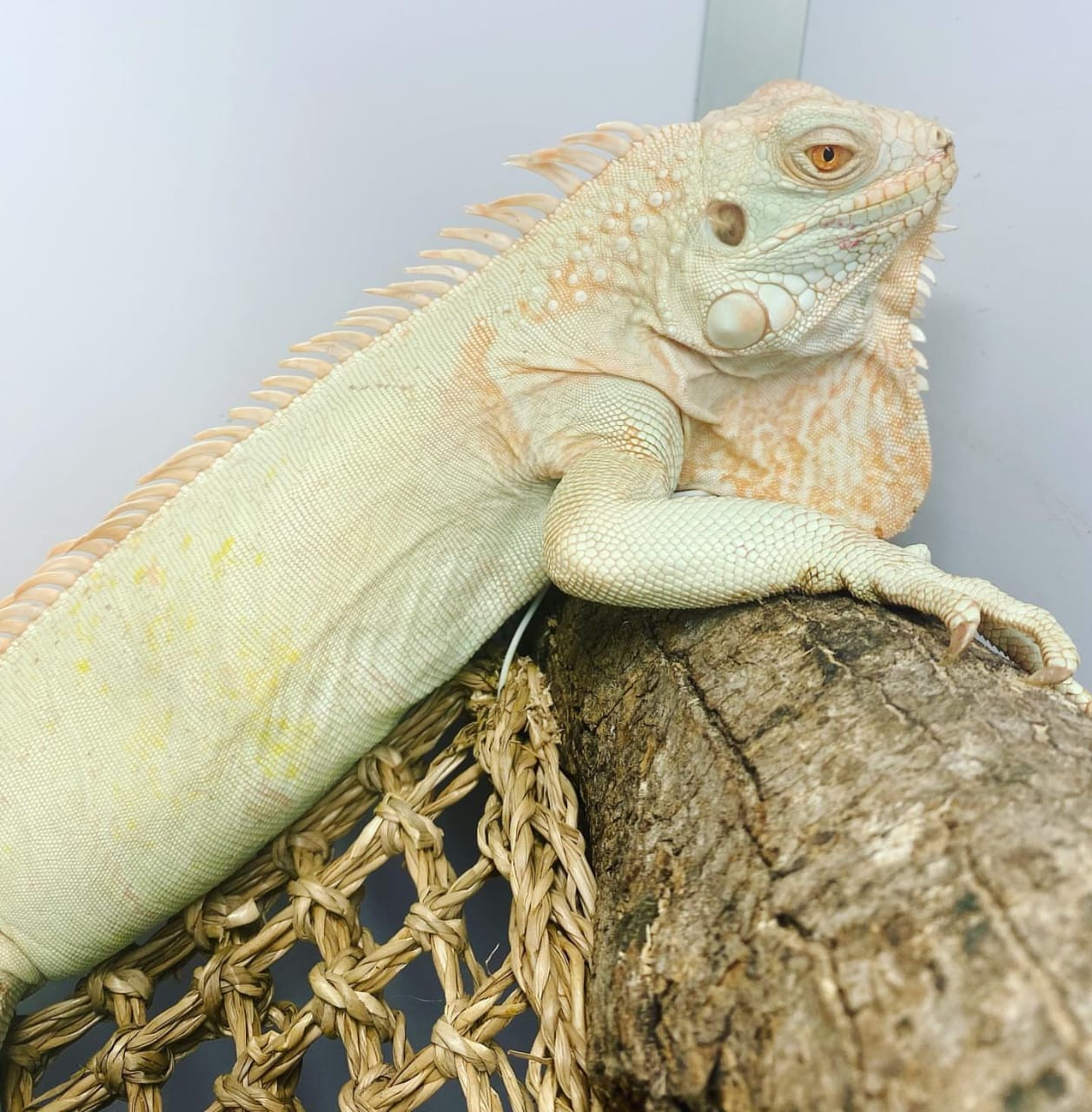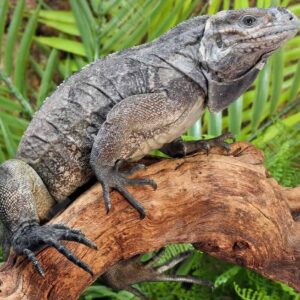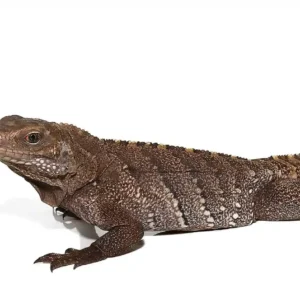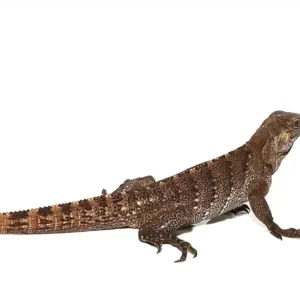Snow Iguana For Sale
$600.00
A very unique iguana, the Snow Iguana is a white iguana that has been developed by crossing a blue iguana with a T- albino. This breed has a complete white body, including their eyes and scales.
Snow Iguana are great pets that can live to be over 25 years old in the right care. They are omnivores and eat plant matter, insects, fruits and carrion.
They are diurnal and bask in the sun to warm up at the beginning of the day. At night they hide in rock crevices, caves and under buildings or piles of construction material.
Snow Iguana are very sensitive to cold and when temperatures drop below 45 degrees F, they enter a state of dormant (cold-stunned) behavior. This is their bodies’ way of protecting them until the weather warms up again.
Their skin coloration works as a camouflage and helps them evade predators. Iguanas also have parietal bulges and spines on their back that work as a defense.
They have four legs with long fingers and sharp claws. They use these sharp digits to climb trees and hang on branches, and they also have soft spikes that help them scare off predators from their back.
Snow Iguana can become aggressive if they are not properly cared for, so it is important to keep them in a secure cage with a temperature-controlled environment and plenty of space. Ideally, they should be kept outdoors so they can bask in the sun to keep them hydrated.
Description
The snow iguana, scientifically known as Iguana glacialis, is an extraordinary creature that defies typical expectations of cold-blooded reptiles. While most iguanas are synonymous with tropical and subtropical climates, the snow iguana thrives in markedly colder environments. Found primarily in the high-altitude regions of the Andes Mountains, this unique reptile has fascinated biologists and herpetologists alike due to its remarkable survival strategies.
The moniker ‘snow iguana’ arises from its uncanny ability to withstand and adapt to frigid temperatures, a feat uncommon for its reptilian kin. This iguana’s skin, which ranges from a pale grey to a greenish hue, provides not only camouflage against the rocky, snowy terrain but also aids in temperature regulation. The snow iguana has developed several physiological and behavioral adaptations that allow it to endure the cold.
One of the most notable adaptations is its ability to slow down its metabolic rate significantly. During the coldest periods, the snow iguana enters a state akin to hibernation, known as brumation. This process involves a drastic reduction in activity and metabolic functions, enabling the iguana to conserve energy until temperatures rise again. Additionally, the snow iguana has a unique circulatory system that minimizes heat loss, ensuring essential bodily functions are maintained even in low temperatures.
Furthermore, the snow iguana’s diet is adapted to its harsh environment. It primarily feeds on hardy, cold-resistant vegetation and occasionally small insects that are able to survive in these extreme conditions. Its foraging behavior is carefully timed to periods when temperatures are slightly warmer, maximizing its chances of survival.
Ultimately, the snow iguana stands as a testament to the incredible adaptability of life. Its ability to survive in an environment that would be inhospitable to most of its relatives highlights the diverse and often surprising ways in which species evolve to face the challenges of their habitats.
The Evolutionary Journey of the Snow Iguana
The snow iguana, a fascinating cold-blooded survivor, has a rich evolutionary history that traces back millions of years. Originating from warmer, tropical ancestors, the snow iguana has undergone significant adaptations to thrive in colder climates. These evolutionary changes were driven by a combination of environmental pressures and natural selection, allowing the species to carve out a niche in frigid habitats.
Fossil records indicate that the ancestors of the snow iguana were more akin to modern-day tropical iguanas, living in lush, warm environments. As climatic conditions shifted and colder regions became more prevalent, these ancient reptiles faced new survival challenges. Those that could not adapt either migrated to warmer areas or faced extinction. However, a subset of these iguanas began to exhibit traits that favored survival in cooler temperatures.
Key adaptations include changes in their metabolic processes, allowing them to maintain body functions at lower temperatures. Additionally, the snow iguana developed unique behavioral patterns, such as basking in the sun to absorb heat more efficiently and reducing activity levels during extreme cold. Their coloration also evolved to blend seamlessly with snowy and rocky environments, providing camouflage from predators.
Significant studies have shed light on these evolutionary developments. Research on mitochondrial DNA has revealed genetic modifications that correlate with cold adaptation. Moreover, paleontological discoveries have unearthed transitional fossils that showcase the gradual morphological changes from warm-climate iguanas to the snow iguana’s current form. These fossils, found in regions that were once temperate but have since cooled, offer a chronological map of the snow iguana’s journey.
The snow iguana’s evolutionary path is a testament to the power of adaptation and resilience. It highlights the intricate relationship between organisms and their environments, demonstrating how species can evolve remarkable traits to survive and even thrive under challenging conditions.
Physical Adaptations for Cold Weather
The snow iguana, a remarkable cold-blooded reptile, has evolved several physical adaptations that allow it to survive and thrive in colder climates. Unlike its tropical relatives, the snow iguana has developed unique thermoregulation abilities that are crucial for its survival. Thermoregulation, the process by which these reptiles maintain their body temperature within certain boundaries, is essential for their metabolic and physiological functions.
One of the most significant adaptations of the snow iguana is its skin. Unlike the smooth and often brightly colored skin of other iguana species, the snow iguana’s skin is thicker and contains specialized cells that help in heat absorption and retention. This unique skin texture not only provides a layer of insulation but also aids in maintaining a stable body temperature during the frigid nights. The coloration of the skin, often a mix of dull greens and browns, further assists in camouflage, blending seamlessly with their snowy and rocky habitats.
Behavioral adaptations also play a critical role in the snow iguana’s ability to endure cold temperatures. These iguanas are known to bask in the sun during the day, absorbing as much heat as possible, which is then stored and slowly released during the colder nights. This basking behavior is a stark contrast to the more shade-loving habits of tropical iguanas. Additionally, during extreme cold, snow iguanas seek shelter in burrows or under rocks, minimizing exposure to the harsh environment.
Comparatively, tropical iguanas lack these cold-weather adaptations, relying instead on consistently warm environments to regulate their body temperature. The snow iguana’s ability to adapt behaviorally and physically to cold climates underscores its uniqueness among iguana species, showcasing nature’s incredible capability for diversification and survival in varied ecosystems.
Diet and Hunting Strategies
The diet of the snow iguana is a fascinating aspect of its adaptation to the cold environment. Unlike its tropical relatives that primarily consume a variety of fruits, leaves, and insects, the snow iguana has developed a unique feeding strategy to survive in harsher climates. Its primary food sources include lichens, mosses, and small invertebrates that are abundant in its habitat. During the warmer months, the snow iguana may also forage for higher-protein foods such as small rodents and birds, which provide essential nutrients for its survival.
Hunting techniques of the snow iguana are adapted to the slower pace necessitated by the colder climate. It employs a combination of ambush and active hunting strategies. The snow iguana often remains motionless, camouflaged against the snow and rocks, waiting for unsuspecting prey to come within striking distance. This energy-efficient method reduces the need for unnecessary movement, conserving valuable energy reserves. When necessary, the snow iguana can also actively search for food, using its keen sense of smell and sight to locate potential meals hidden beneath the snow or in crevices.
Seasonal variations play a significant role in the snow iguana’s diet. During the winter months, when food is scarce, it relies more heavily on its fat reserves and reduces its metabolic rate to conserve energy. The snow iguana may also exhibit a form of torpor, a state of decreased physiological activity, to survive periods of extreme cold and food scarcity. Conversely, in the warmer seasons, it becomes more active and opportunistic, taking advantage of the increased availability of food sources to replenish its energy stores.
The colder climate presents significant challenges for the snow iguana, particularly in terms of food availability. To cope with these challenges, it has evolved to be a highly adaptable and resourceful predator. Its ability to modify its diet and hunting strategies according to seasonal changes ensures its survival in one of the most inhospitable environments on earth.
Reproduction and Life Cycle
The reproductive behavior and life cycle of the snow iguana are intriguing, especially given its adaptation to cold environments. Mating rituals in snow iguanas are marked by a series of displays and behaviors where males showcase their dominance through physical postures and head-bobbing. These displays are crucial in attracting females and establishing mating rights.
Once a female selects a mate, the nesting process begins. Snow iguanas exhibit a unique nesting behavior due to the cold climate they inhabit. Females dig burrows in the snow or soil to lay their eggs, ensuring they are well insulated from the harsh external temperatures. The nesting sites are often chosen based on factors like temperature stability and protection from predators.
The incubation period for snow iguana eggs is notably longer compared to their tropical counterparts, often extending to several months. This extended period is a direct adaptation to the cold environment, where warmer temperatures that hasten development are unavailable. The cold environment also influences the survival rate of the offspring, with only the most resilient hatchlings surviving to adulthood.
Remarkably, snow iguanas have developed specific behaviors to ensure the continuation of their species. For example, some females exhibit communal nesting, where multiple females lay their eggs in close proximity. This strategy not only maximizes the use of optimal nesting sites but also offers increased protection against predators.
Additionally, snow iguana hatchlings are born with a higher level of fat reserves compared to other iguanas. This adaptation allows them to endure the cold and scarce food availability immediately after hatching. Their early life is spent in relative inactivity, conserving energy until the environment becomes more favorable for growth and development.
The reproductive strategies and life cycle adaptations of snow iguanas are a testament to their resilience and evolutionary ingenuity. By understanding these unique behaviors, we gain insight into how this species thrives in one of the most challenging habitats on earth.
Interaction with Ecosystem and Other Species
The snow iguana, a remarkable cold-blooded survivor, plays a crucial role in its ecosystem. As an integral component of the food chain, it occupies a unique position, both as a predator and prey. The snow iguana primarily feeds on a diverse range of vegetation, including mosses, lichens, and small shrubs. This herbivorous diet helps to regulate the growth of local flora, contributing to the balance of the ecosystem.
In addition to its role as a herbivore, the snow iguana also preys on insects and small invertebrates, thereby controlling their populations. This dual feeding strategy ensures the snow iguana’s survival in its harsh, cold environment while maintaining ecological equilibrium. Furthermore, the snow iguana’s droppings act as a natural fertilizer, enriching the soil and promoting plant growth, which in turn supports a myriad of other species.
The snow iguana shares symbiotic relationships with various organisms. For instance, certain bird species rely on the iguana for food, scavenging on the remains of its prey. Additionally, some insects are known to clean the iguana’s skin, providing a mutual benefit by obtaining nourishment while keeping the iguana free from parasites.
Despite its adaptability, the snow iguana faces several threats from both natural predators and human activities. Predatory birds and mammals pose a significant risk, especially to juvenile iguanas. Human encroachment, habitat destruction, and climate change further exacerbate these threats, potentially leading to a decline in snow iguana populations.
Nevertheless, the snow iguana’s presence is pivotal to the biodiversity of its habitat. By participating in various ecological processes, it supports a wide array of species, thereby enhancing the resilience and health of its ecosystem. Conservation efforts focused on protecting the snow iguana and its habitat are essential to preserve this unique species and the intricate web of life it sustains.
Conservation Status and Threats
The snow iguana, a unique cold-blooded survivor, faces significant challenges in maintaining its population. Currently, the species is listed as vulnerable on the International Union for Conservation of Nature (IUCN) Red List. This status underscores the precarious balance between the snow iguana’s resilience and the mounting threats it faces. One of the primary threats to its survival is habitat destruction. As human activities expand, the natural habitats of the snow iguana are increasingly encroached upon, leading to a reduction in the areas where these iguanas can thrive.
Climate change also poses a serious threat to the snow iguana. As temperatures rise and weather patterns become more unpredictable, the delicate ecosystems that support the iguana are disrupted. Changes in temperature can affect the iguana’s ability to regulate its body temperature, a critical factor for cold-blooded animals. Additionally, altered precipitation patterns can impact the availability of food and water sources, further endangering the species.
Human interference, including illegal poaching and the introduction of invasive species, exacerbates the threats to the snow iguana. Poaching for the pet trade and for their skins has significantly reduced their numbers in the wild. Invasive species, such as certain predatory animals and competitive flora, disrupt the ecological balance, often resulting in diminished iguana populations.
Despite these challenges, ongoing conservation efforts offer hope for the snow iguana’s future. Protected areas have been established to safeguard critical habitats, ensuring that these environments remain undisturbed by human activities. Breeding programs aim to boost population numbers and reintroduce iguanas into their natural habitats. These initiatives are complemented by community education programs designed to raise awareness about the snow iguana’s plight and foster local support for conservation efforts.
To ensure the continued existence of the snow iguana, it is imperative to strengthen and expand these conservation efforts. This includes enforcing stricter regulations against habitat destruction and poaching, enhancing climate resilience strategies, and promoting sustainable coexistence between human populations and wildlife. Through concerted global and local efforts, we can help secure a future where the snow iguana continues to thrive in its natural environment.










